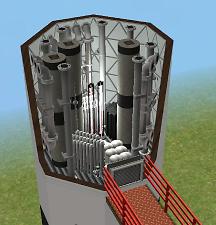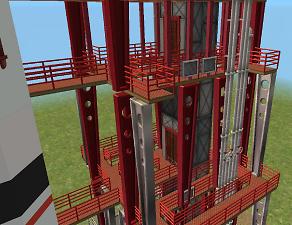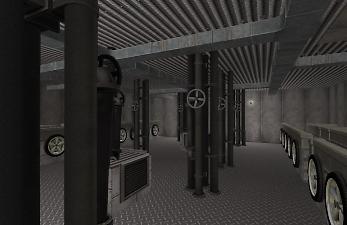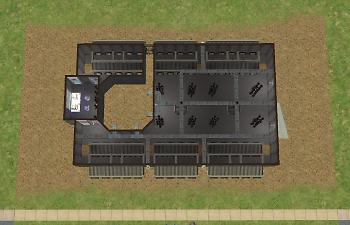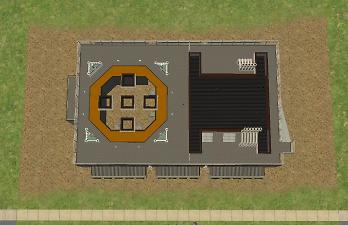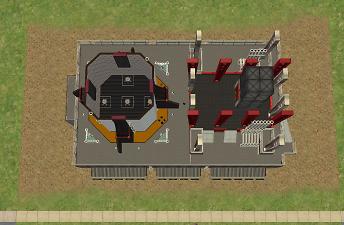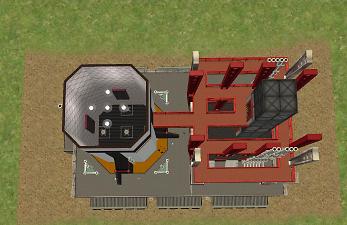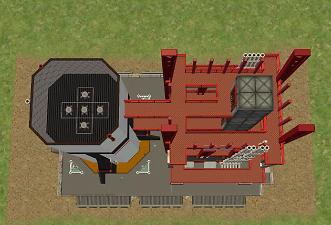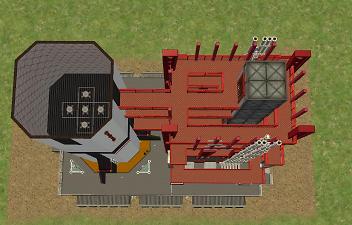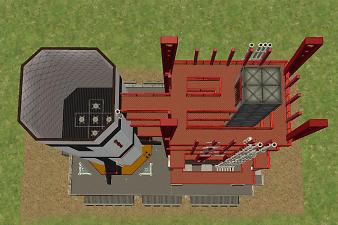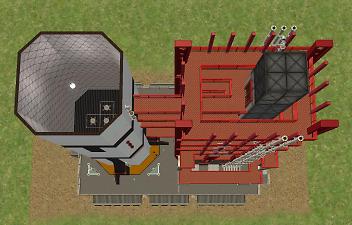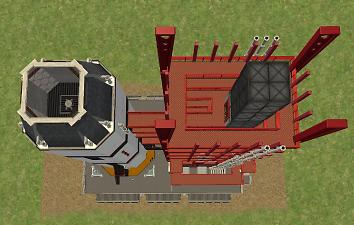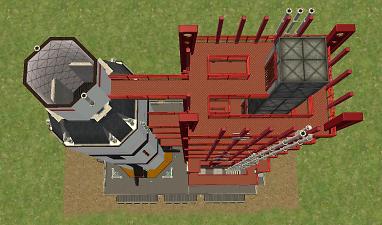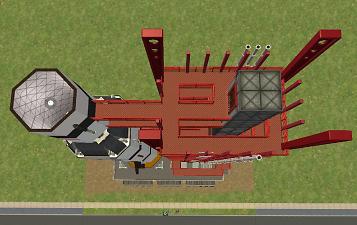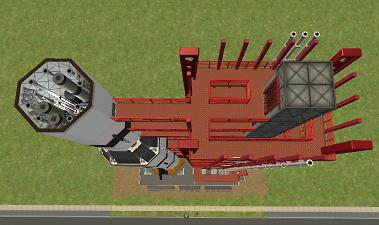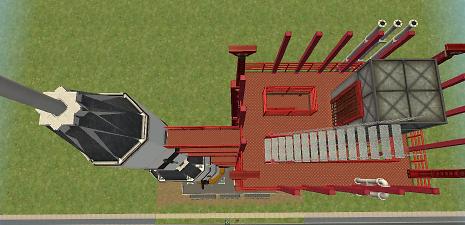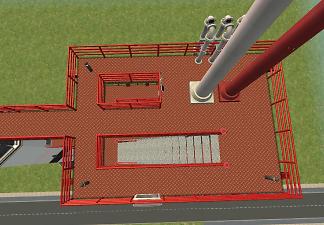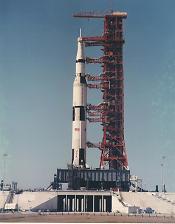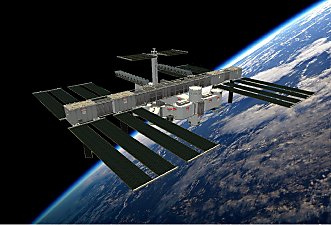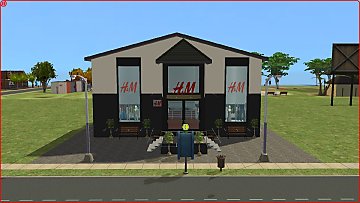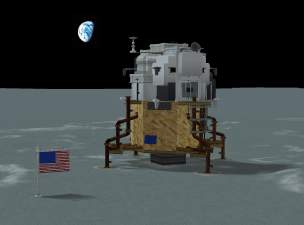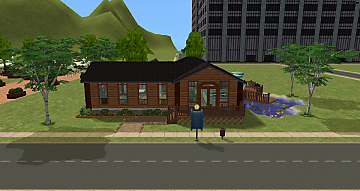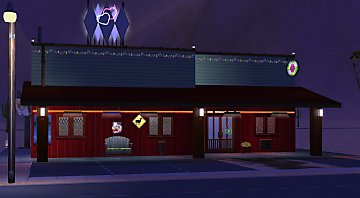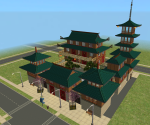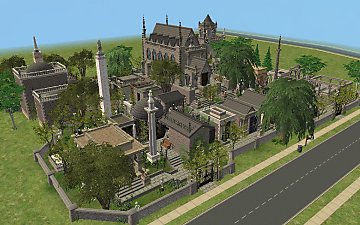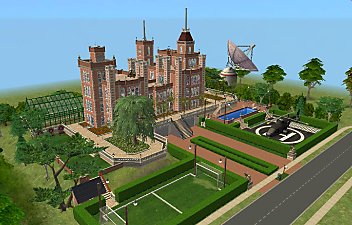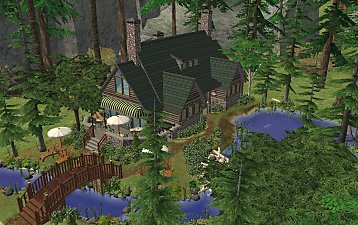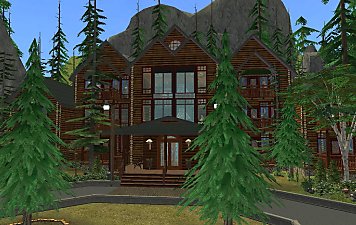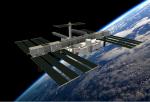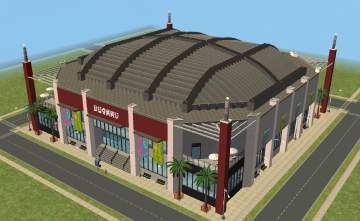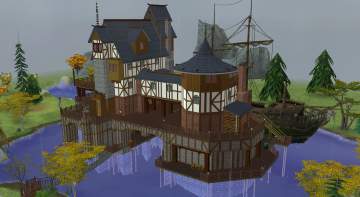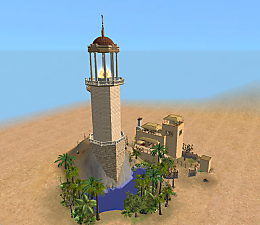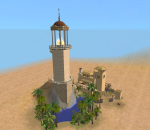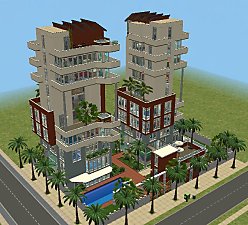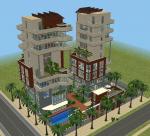 Apollo 11 - Saturn V Rocket - NO CC
Apollo 11 - Saturn V Rocket - NO CC

A11 Prof.jpg - width=467 height=871

A11 Service Module.jpg - width=844 height=880

A11 Tower.jpg - width=1147 height=883

A11 Crawler.jpg - width=1364 height=885

A11 1st Floor.jpg - width=1379 height=886

A11 2nd Floor.jpg - width=1372 height=886

A11 3rd & 4th Floor.jpg - width=1345 height=879

A11 5th & 6th Floor.jpg - width=1353 height=878

A11 7th Floor.jpg - width=1292 height=879

A11 8th Floor.jpg - width=1378 height=881

A11 9th Floor.jpg - width=1316 height=876

A11 10th Floor.jpg - width=1380 height=883

A11 11th Floor.jpg - width=1380 height=878

A11 12th Floor.jpg - width=1385 height=815

A11 13th Floor.jpg - width=1350 height=852

A11 14th Floor.jpg - width=1316 height=782

A11 15th Floor.jpg - width=1430 height=692

A11 Top.jpg - width=1208 height=839

A11 Real-World.jpg - width=599 height=768



















| "That's one small step for [a] man, one giant leap for Mankind." |
On July 20th, 1969, these immortal words were spoken as a representative of humanity set foot for the first time ever on a world beyond our own. Apollo 11 flew astronauts Neil Armstrong, Buzz Aldrin, and Michael Collins to the Moon, and Armstrong and Aldrin were the first of twelve people in all of human history to ever walk on another celestial body.
Their unbelievable journey started on July 16th, 1969, when they launched from the Kennedy Space Center at 13:32UTC, atop the most powerful vehicle ever designed, the Saturn V rocket (in their case, specifically, SA-506), and it is this incredible vehicle that I present to you with this timely lot upload. (Also, since one of the suggestions for this month's theme was "crossing the globe in a second," what could be better than a rocket that almost lets you do just that? (it's just a bit slower than that!))
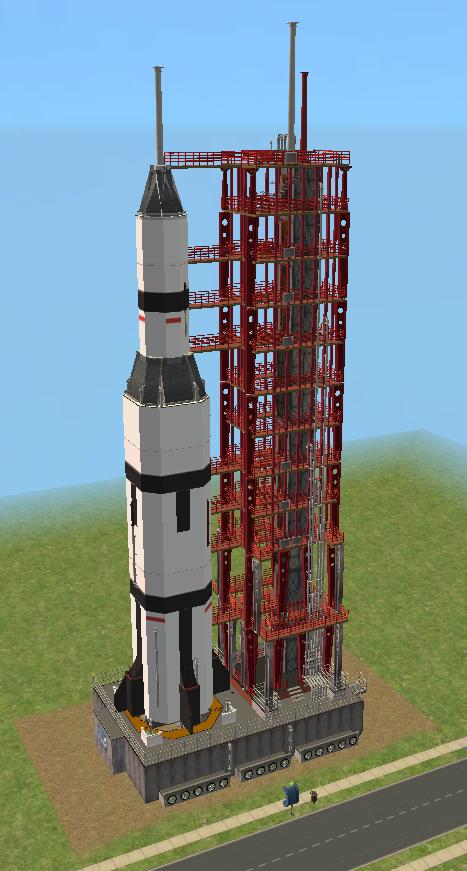
The Saturn V is what is known as an expendable multi-stage rocket, meaning that it is not a reusable launch vehicle like the Space Shuttle, and that it has multiple sections that ignite in sequence to lift it into Earth orbit, and then fire again to propel the spacecraft towards the Moon. In the case of the Saturn V, there are three stages used to launch the actual flight vehicles, the Command/Service Modules (CSM) and the Lunar Module (LM).
The launch of a Saturn V rocket is an incredible achievement in its own right- this vehicle is the size of a skyscraper which is moved to the launch pad by one of the largest treaded vehicles in history (the glorified tank on the bottom of the superstructure), then filled with millions of pounds of cryogenic fuels (which if accidentally ignited would create an explosion greater than two thousand TONS of TNT) that are then deliberately ignited to allow this monumental craft to break the pull of Earth's gravity and escape into the heavens.
Once the countdown clock reached zero and the five main engines were ignited, the Saturn V would be held down on the pad by a series of restraints until it had built up enough thrust to lift off. It took approximately 12 seconds for the rocket to clear the launch tower, considered by most Apollo astronauts to be the tensest part of the entire mission, as a failure at this point could result in the entire rocket falling back to Earth with almost no opportunity for the astronauts to make an abort escape launch.
As the first stage burned, it consumed fuel at more than 13 tonnes every second, with the entire stage having been expended in just two minutes and 41 seconds. At this point, the rocket would be somewhere in the neighborhood of 42 miles above the surface of the Earth, and well out over the Atlantic Ocean. Once the first stage was expended, it would be jettisoned to reenter and splash down in the ocean far downrange. At the same time, the five engines of the second stage would ignite, burning for an additional 6 minutes and lifting the rocket more than 100 miles above the Earth's surface.
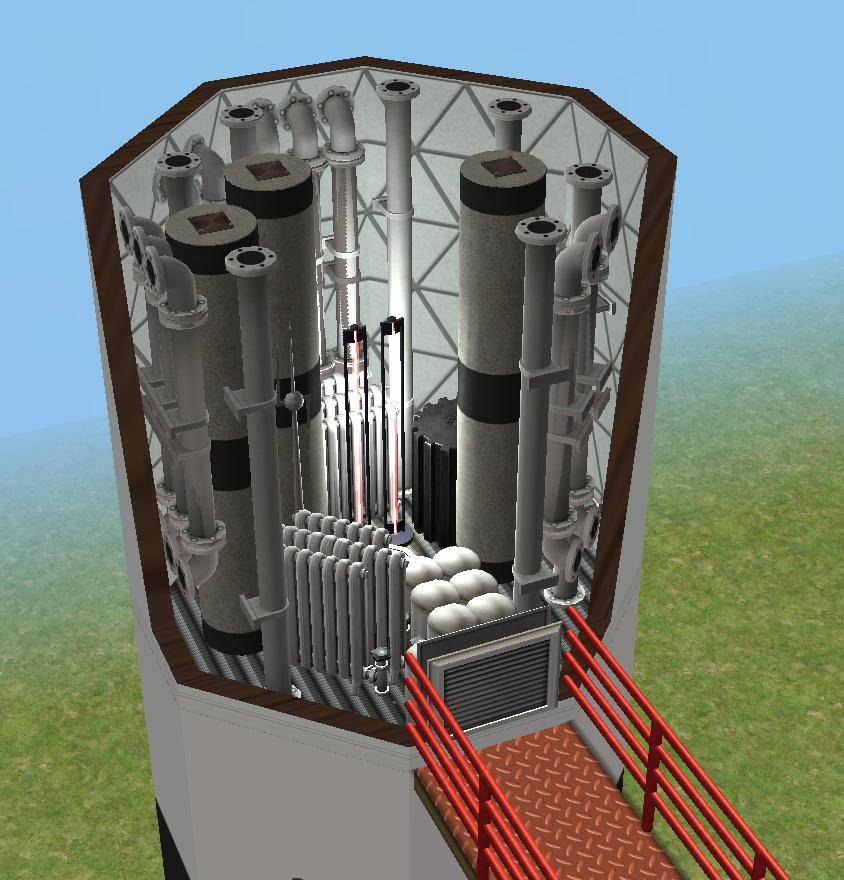
The second stage would be jettisoned just like the first had been, at which point the third stage would ignite its single engine, lifting the rocket (now considerably smaller) into a parking orbit while the astronauts and mission control staff ran systems checks to make sure that everything was prepared to leave Earth orbit and head to the Moon (a maneuver know as trans-lunar injection). Once it was established that this could be performed safely, the third stage would fire again, propelling the craft out of the Earth's gravity well and on its way to the Moon.
Once this was completed, the astronauts on board would separate the CSM from the rest of the vehicle, then turn around and connect to and draw out the LM, giving the familiar silhouette of the Apollo spacecraft. The third stage would then be directed into either a solar orbit similar to the Earth's (essentially to keep it out of the way), or on later missions, directed to crash into the lunar surface to generate a seismic event that could be used to calibrate instruments left on the Moon by earlier missions.
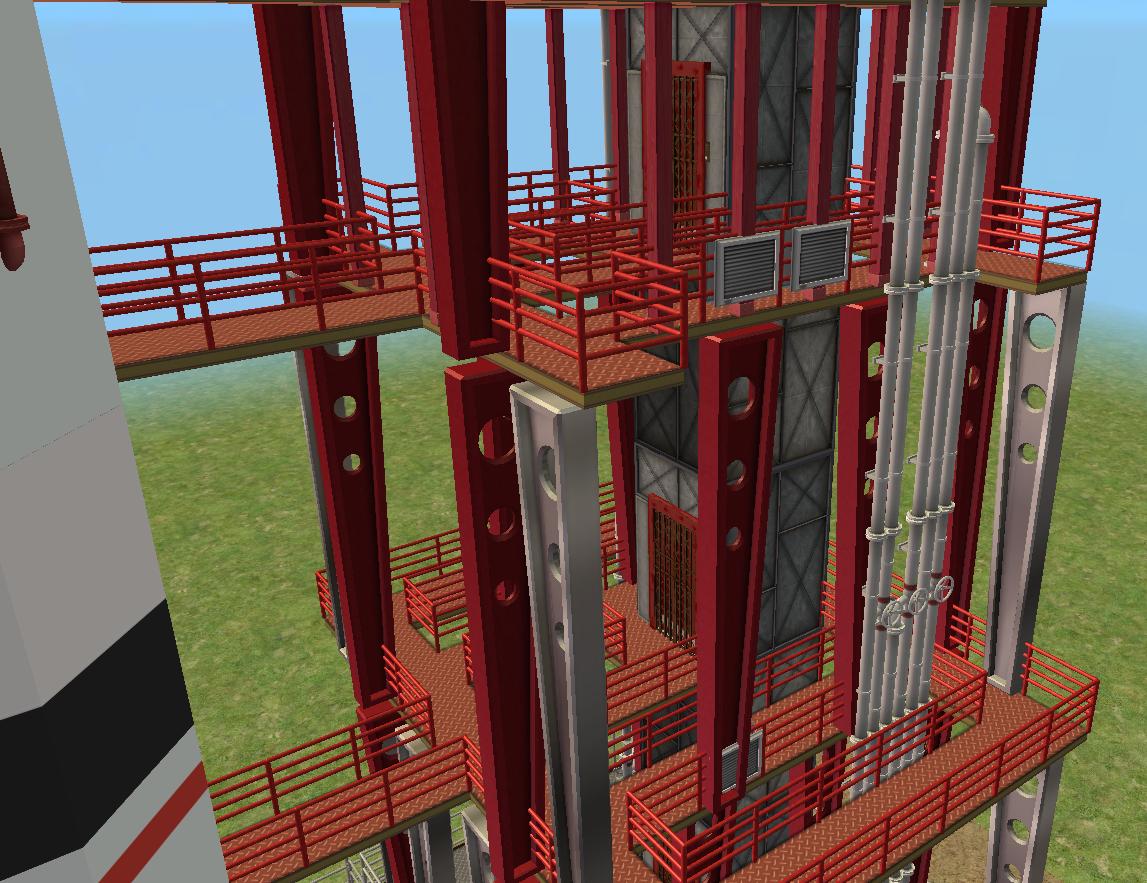
The rest of the mission no longer uses the Saturn V, but still- it's interesting!
Once the spacecraft reached the moon, the smaller engine on the CSM would fire, slowing the combined vehicles enough to enter lunar orbit, at which point the two astronauts who would walk on the Moon's surface would enter the LM and separate from the CSM, descending towards the lunar surface. The LM would fire its descent stage engine to slow enough for a gentle landing, and the astronauts would perform the lunar portion of their mission, with one or a series of extravehicular activities (EVAs) during which the astronauts would actually be out on the lunar surface.
At the conclusion of the lunar expedition, the astronauts would return to the LM, and fire a smaller engine that would separate the ascent stage and return it to lunar orbit (the descent stage would remain on the Moon- with a powerful enough telescope, you can actually still see them!) for a rendezvous with the third crew member in the orbiting CSM.
The LM ascent stage would be jettisoned once the crew was reunited, and the CSM would be used for the return to Earth, with its engine being fired again to escape the Moon's gravity and accelerate back towards the Earth. The spacecraft would NOT enter Earth orbit again upon reaching our little blue world- instead, the service module would be jettisoned, and a precise angle of descent would have to be made. This was so that the Command Module would be pointed just right, so that it would neither enter the atmosphere too steeply (resulting in the vehicle being heated too dramatically and essentially becoming a shooting star- not an ideal situation when there are three people inside!) nor too shallowly (which would essentially see the CM deflecting off the atmosphere and back into space with no way to return to Earth, in much the same way a stone can be skipped off the surface of a lake- again, not ideal when three lives are being considered!)
After a successful atmospheric reentry, the Command Module would be slowed to around 300 mph, at which point a series of parachutes would be deployed, slowing it even further, until it splashed down in the ocean at a gentle 15-20 mph. The astronauts would be picked up by naval vessels in the area, and given a hero's welcome upon returning to the United States.
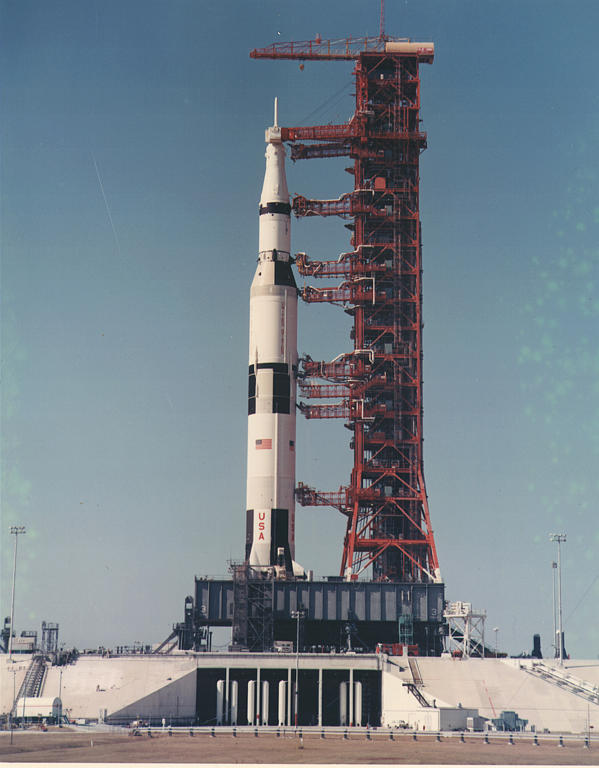
OK, now time for the in-game lot! I'll state right up front- this lot is utterly useless! It doesn't do anything, and even for a visit there isn't much of anything for Sims to do, but I wanted to see if I could make a convincing Saturn V by July 20th! (I'd actually started this lot hoping to have it done by July 20th of LAST year, but I wasn't able to get a number of elements to work properly in time, so I put it off until THIS year's July 20th!) About all it's good for is storytelling and in-game photography, but for that, I'd like to think it's pretty much perfect!
 I did test a clone of the lot, and Sims can access any of the levels of the launch tower (but there is no access into the rocket itself, as the Command Module is one of the sections represented by roofing objects!)
I did test a clone of the lot, and Sims can access any of the levels of the launch tower (but there is no access into the rocket itself, as the Command Module is one of the sections represented by roofing objects!)The different stages of the rocket are represented, with the first stage engines being represented by CFE'd wall sections, and every other set of engines by a ceiling light (each engine also has a flamethrower sculpture above it, because come on- there's gotta be flame somewhere on a rocket, right?
Because of my having them all when I made the lot, all EPs are required- I don't think many SPs should be required, but because I haven't the faintest idea where some of the flooring and wallpaper I used came from, I listed them all, just to be on the safe side! You can probably get by without a lot of them, though I know M&G and IKEA were used here.
As I've noted before, the Saturn V is essentially a skyscraper-sized vehicle, which means that this is a skyscraper-sized lot! It's mostly empty though, so it doesn't lag anywhere near as much as a fully furnished building on the same scale would do! The second level is CFE'd to represent the first stage engines, so any lot alterations that you decide to make should take that into account! As I said, I made a clone of this lot to playtest (as much as there IS to test!), and found no major issues, but if you find anything problematic in your game, let me know and I'll try to fix it straightaway!
| "Houston, Tranquility Base here- The Eagle has landed." |
Lot Size: 2x3
Lot Price (furnished): $149, 092
Additional Credits:
The real-life Saturn V was developed by a huge team, led by noted rocket scientists Wernher von Braun and Arthur Randolph- not a building, per se, but still- credit for the design of this lot is due to them.
|
Apollo 11 Saturn V.zip
Download
Uploaded: 2nd Jun 2016, 2.09 MB.
1,932 downloads.
|
||||||||
| For a detailed look at individual files, see the Information tab. | ||||||||
Install Instructions
1. Download: Click the download link to save the .rar or .zip file(s) to your computer.
2. Extract the zip, rar, or 7z file.
3. Install: Double-click on the .sims2pack file to install its contents to your game. The files will automatically be installed to the proper location(s).
- You may want to use the Sims2Pack Clean Installer instead of the game's installer, which will let you install sims and pets which may otherwise give errors about needing expansion packs. It also lets you choose what included content to install. Do NOT use Clean Installer to get around this error with lots and houses as that can cause your game to crash when attempting to use that lot. Get S2PCI here: Clean Installer Official Site.
- For a full, complete guide to downloading complete with pictures and more information, see: Game Help: Downloading for Fracking Idiots.
- Custom content not showing up in the game? See: Game Help: Getting Custom Content to Show Up.
Loading comments, please wait...
Uploaded: 20th Jul 2015 at 9:06 AM
Updated: 23rd Aug 2019 at 11:54 PM
#no cc, #themeworld, #apollo, #apollo 11, #moon, #lunar, #rocket, #NASA, #astronaut, #USA, #1969, #florida, #space, #planet, #neil armstrong, #buzz aldrin, #michael collins, #stars, #liftoff, #tower, #tranquility base, #eagle, #columbia, #space race
-
International Space Station - NO CC
by Zarathustra updated 1st Jun 2016 at 4:54am
 +17 packs
32 29.2k 82
+17 packs
32 29.2k 82 Happy Holiday
Happy Holiday
 Family Fun
Family Fun
 University
University
 Glamour Life
Glamour Life
 Nightlife
Nightlife
 Celebration
Celebration
 Open for Business
Open for Business
 Pets
Pets
 H&M Fashion
H&M Fashion
 Teen Style
Teen Style
 Seasons
Seasons
 Kitchen & Bath
Kitchen & Bath
 Bon Voyage
Bon Voyage
 Free Time
Free Time
 Ikea Home
Ikea Home
 Apartment Life
Apartment Life
 Mansion and Garden
Mansion and Garden
-
by lilmisssimsaddict 12th Jun 2019 at 11:57pm
 +17 packs
4.4k 8
+17 packs
4.4k 8 Happy Holiday
Happy Holiday
 Family Fun
Family Fun
 University
University
 Glamour Life
Glamour Life
 Nightlife
Nightlife
 Celebration
Celebration
 Open for Business
Open for Business
 Pets
Pets
 H&M Fashion
H&M Fashion
 Teen Style
Teen Style
 Seasons
Seasons
 Kitchen & Bath
Kitchen & Bath
 Bon Voyage
Bon Voyage
 Free Time
Free Time
 Ikea Home
Ikea Home
 Apartment Life
Apartment Life
 Mansion and Garden
Mansion and Garden
-
Apollo 11 - Tranquility Base - NO CC
by Zarathustra 28th Jul 2019 at 11:48pm
 +17 packs
10 6.6k 13
+17 packs
10 6.6k 13 Happy Holiday
Happy Holiday
 Family Fun
Family Fun
 University
University
 Glamour Life
Glamour Life
 Nightlife
Nightlife
 Celebration
Celebration
 Open for Business
Open for Business
 Pets
Pets
 H&M Fashion
H&M Fashion
 Teen Style
Teen Style
 Seasons
Seasons
 Kitchen & Bath
Kitchen & Bath
 Bon Voyage
Bon Voyage
 Free Time
Free Time
 Ikea Home
Ikea Home
 Apartment Life
Apartment Life
 Mansion and Garden
Mansion and Garden
-
by Andytampan 8th Dec 2023 at 11:48am
 +17 packs
1.8k 4
+17 packs
1.8k 4 Happy Holiday
Happy Holiday
 Family Fun
Family Fun
 University
University
 Glamour Life
Glamour Life
 Nightlife
Nightlife
 Celebration
Celebration
 Open for Business
Open for Business
 Pets
Pets
 H&M Fashion
H&M Fashion
 Teen Style
Teen Style
 Seasons
Seasons
 Kitchen & Bath
Kitchen & Bath
 Bon Voyage
Bon Voyage
 Free Time
Free Time
 Ikea Home
Ikea Home
 Apartment Life
Apartment Life
 Mansion and Garden
Mansion and Garden
-
by Entity.Sims 25th Apr 2024 at 1:29pm
 +17 packs
2k 8
+17 packs
2k 8 Happy Holiday
Happy Holiday
 Family Fun
Family Fun
 University
University
 Glamour Life
Glamour Life
 Nightlife
Nightlife
 Celebration
Celebration
 Open for Business
Open for Business
 Pets
Pets
 H&M Fashion
H&M Fashion
 Teen Style
Teen Style
 Seasons
Seasons
 Kitchen & Bath
Kitchen & Bath
 Bon Voyage
Bon Voyage
 Free Time
Free Time
 Ikea Home
Ikea Home
 Apartment Life
Apartment Life
 Mansion and Garden
Mansion and Garden
-
by Entity.Sims 27th May 2024 at 12:59am
 +17 packs
2 2.4k 10
+17 packs
2 2.4k 10 Happy Holiday
Happy Holiday
 Family Fun
Family Fun
 University
University
 Glamour Life
Glamour Life
 Nightlife
Nightlife
 Celebration
Celebration
 Open for Business
Open for Business
 Pets
Pets
 H&M Fashion
H&M Fashion
 Teen Style
Teen Style
 Seasons
Seasons
 Kitchen & Bath
Kitchen & Bath
 Bon Voyage
Bon Voyage
 Free Time
Free Time
 Ikea Home
Ikea Home
 Apartment Life
Apartment Life
 Mansion and Garden
Mansion and Garden
-
by vulcansixam updated 28th Aug 2024 at 4:27pm
 +17 packs
5 4.6k 13
+17 packs
5 4.6k 13 Happy Holiday
Happy Holiday
 Family Fun
Family Fun
 University
University
 Glamour Life
Glamour Life
 Nightlife
Nightlife
 Celebration
Celebration
 Open for Business
Open for Business
 Pets
Pets
 H&M Fashion
H&M Fashion
 Teen Style
Teen Style
 Seasons
Seasons
 Kitchen & Bath
Kitchen & Bath
 Bon Voyage
Bon Voyage
 Free Time
Free Time
 Ikea Home
Ikea Home
 Apartment Life
Apartment Life
 Mansion and Garden
Mansion and Garden
-
by Andytampan 28th Oct 2024 at 11:44pm
 +17 packs
1.8k 4
+17 packs
1.8k 4 Happy Holiday
Happy Holiday
 Family Fun
Family Fun
 University
University
 Glamour Life
Glamour Life
 Nightlife
Nightlife
 Celebration
Celebration
 Open for Business
Open for Business
 Pets
Pets
 H&M Fashion
H&M Fashion
 Teen Style
Teen Style
 Seasons
Seasons
 Kitchen & Bath
Kitchen & Bath
 Bon Voyage
Bon Voyage
 Free Time
Free Time
 Ikea Home
Ikea Home
 Apartment Life
Apartment Life
 Mansion and Garden
Mansion and Garden
-
Cascadia Meditation Center - NO CC
by Zarathustra 8th Jun 2025 at 10:55pm
 +17 packs
1.1k 4
+17 packs
1.1k 4 Happy Holiday
Happy Holiday
 Family Fun
Family Fun
 University
University
 Glamour Life
Glamour Life
 Nightlife
Nightlife
 Celebration
Celebration
 Open for Business
Open for Business
 Pets
Pets
 H&M Fashion
H&M Fashion
 Teen Style
Teen Style
 Seasons
Seasons
 Kitchen & Bath
Kitchen & Bath
 Bon Voyage
Bon Voyage
 Free Time
Free Time
 Ikea Home
Ikea Home
 Apartment Life
Apartment Life
 Mansion and Garden
Mansion and Garden
-
by Zarathustra 14th Nov 2016 at 4:36am
Who says your Sims can't have a peaceful and beautiful home in which to spend the great Hereafter? more...
 +17 packs
18 34.7k 118
+17 packs
18 34.7k 118 Happy Holiday
Happy Holiday
 Family Fun
Family Fun
 University
University
 Glamour Life
Glamour Life
 Nightlife
Nightlife
 Celebration
Celebration
 Open for Business
Open for Business
 Pets
Pets
 H&M Fashion
H&M Fashion
 Teen Style
Teen Style
 Seasons
Seasons
 Kitchen & Bath
Kitchen & Bath
 Bon Voyage
Bon Voyage
 Free Time
Free Time
 Ikea Home
Ikea Home
 Apartment Life
Apartment Life
 Mansion and Garden
Mansion and Garden
-
X-Men Mansion - Charles Xavier's School for Gifted Youngsters - NO CC
by Zarathustra 31st May 2014 at 2:00pm
An elite private school to the public, this family mansion houses an elaborate superhero training facility and headquarters. more...
 +15 packs
32 42.5k 102
+15 packs
32 42.5k 102 University
University
 Glamour Life
Glamour Life
 Nightlife
Nightlife
 Celebration
Celebration
 Open for Business
Open for Business
 Pets
Pets
 H&M Fashion
H&M Fashion
 Teen Style
Teen Style
 Seasons
Seasons
 Kitchen & Bath
Kitchen & Bath
 Bon Voyage
Bon Voyage
 Free Time
Free Time
 Ikea Home
Ikea Home
 Apartment Life
Apartment Life
 Mansion and Garden
Mansion and Garden
-
Hidden Creek Refectory - NO CC
by Zarathustra 16th Jul 2016 at 5:41am
Vacation Contest Round 2 - Historic lodge and snack bar next to a beaver pond. more...
 +17 packs
10 20.3k 50
+17 packs
10 20.3k 50 Happy Holiday
Happy Holiday
 Family Fun
Family Fun
 University
University
 Glamour Life
Glamour Life
 Nightlife
Nightlife
 Celebration
Celebration
 Open for Business
Open for Business
 Pets
Pets
 H&M Fashion
H&M Fashion
 Teen Style
Teen Style
 Seasons
Seasons
 Kitchen & Bath
Kitchen & Bath
 Bon Voyage
Bon Voyage
 Free Time
Free Time
 Ikea Home
Ikea Home
 Apartment Life
Apartment Life
 Mansion and Garden
Mansion and Garden
-
by Zarathustra 16th Jul 2016 at 5:41am
Vacation Contest Round 3 - Grand National Park railway hotel. more...
 +17 packs
13 20.6k 48
+17 packs
13 20.6k 48 Happy Holiday
Happy Holiday
 Family Fun
Family Fun
 University
University
 Glamour Life
Glamour Life
 Nightlife
Nightlife
 Celebration
Celebration
 Open for Business
Open for Business
 Pets
Pets
 H&M Fashion
H&M Fashion
 Teen Style
Teen Style
 Seasons
Seasons
 Kitchen & Bath
Kitchen & Bath
 Bon Voyage
Bon Voyage
 Free Time
Free Time
 Ikea Home
Ikea Home
 Apartment Life
Apartment Life
 Mansion and Garden
Mansion and Garden
-
International Space Station - NO CC
by Zarathustra updated 1st Jun 2016 at 4:54am
This orbital station provides a place for astronauts to live and work in a microgravity environment, high above Earth's surface. more...
 +17 packs
32 29.2k 82
+17 packs
32 29.2k 82 Happy Holiday
Happy Holiday
 Family Fun
Family Fun
 University
University
 Glamour Life
Glamour Life
 Nightlife
Nightlife
 Celebration
Celebration
 Open for Business
Open for Business
 Pets
Pets
 H&M Fashion
H&M Fashion
 Teen Style
Teen Style
 Seasons
Seasons
 Kitchen & Bath
Kitchen & Bath
 Bon Voyage
Bon Voyage
 Free Time
Free Time
 Ikea Home
Ikea Home
 Apartment Life
Apartment Life
 Mansion and Garden
Mansion and Garden
-
SimCity Arena - Sports Stadium and Concert Venue - 3 Lots - NO CC
by Zarathustra 18th Feb 2022 at 7:06pm
You know your Sims are really living in a big city when they've got their own major sports teams to more...
 +17 packs
16 12.3k 45
+17 packs
16 12.3k 45 Happy Holiday
Happy Holiday
 Family Fun
Family Fun
 University
University
 Glamour Life
Glamour Life
 Nightlife
Nightlife
 Celebration
Celebration
 Open for Business
Open for Business
 Pets
Pets
 H&M Fashion
H&M Fashion
 Teen Style
Teen Style
 Seasons
Seasons
 Kitchen & Bath
Kitchen & Bath
 Bon Voyage
Bon Voyage
 Free Time
Free Time
 Ikea Home
Ikea Home
 Apartment Life
Apartment Life
 Mansion and Garden
Mansion and Garden
-
Iron Circle River Pirate Fortress - NO CC
by Zarathustra 16th Jan 2022 at 4:57am
Outposts of a distant empire have always interested me, especially once the empire in question isn't really supporting those outposts more...
 +17 packs
9 4.5k 33
+17 packs
9 4.5k 33 Happy Holiday
Happy Holiday
 Family Fun
Family Fun
 University
University
 Glamour Life
Glamour Life
 Nightlife
Nightlife
 Celebration
Celebration
 Open for Business
Open for Business
 Pets
Pets
 H&M Fashion
H&M Fashion
 Teen Style
Teen Style
 Seasons
Seasons
 Kitchen & Bath
Kitchen & Bath
 Bon Voyage
Bon Voyage
 Free Time
Free Time
 Ikea Home
Ikea Home
 Apartment Life
Apartment Life
 Mansion and Garden
Mansion and Garden
-
Adev Caravanserai Beacon - NO CC
by Zarathustra 15th Jan 2023 at 9:27pm
 +17 packs
9 2.7k 8
+17 packs
9 2.7k 8 Happy Holiday
Happy Holiday
 Family Fun
Family Fun
 University
University
 Glamour Life
Glamour Life
 Nightlife
Nightlife
 Celebration
Celebration
 Open for Business
Open for Business
 Pets
Pets
 H&M Fashion
H&M Fashion
 Teen Style
Teen Style
 Seasons
Seasons
 Kitchen & Bath
Kitchen & Bath
 Bon Voyage
Bon Voyage
 Free Time
Free Time
 Ikea Home
Ikea Home
 Apartment Life
Apartment Life
 Mansion and Garden
Mansion and Garden
-
Palm Towers Apartments -CityVille Series
by Zarathustra 27th Jan 2014 at 8:44pm
These double towers will add a fantastic tropical vibe to Downtown or a beachside retirement community. more...
 +15 packs
7 19.4k 57
+15 packs
7 19.4k 57 University
University
 Glamour Life
Glamour Life
 Nightlife
Nightlife
 Celebration
Celebration
 Open for Business
Open for Business
 Pets
Pets
 H&M Fashion
H&M Fashion
 Teen Style
Teen Style
 Seasons
Seasons
 Kitchen & Bath
Kitchen & Bath
 Bon Voyage
Bon Voyage
 Free Time
Free Time
 Ikea Home
Ikea Home
 Apartment Life
Apartment Life
 Mansion and Garden
Mansion and Garden
Packs Needed
| Base Game | |
|---|---|
 | Sims 2 |
| Expansion Pack | |
|---|---|
 | University |
 | Nightlife |
 | Open for Business |
 | Pets |
 | Seasons |
 | Bon Voyage |
 | Free Time |
 | Apartment Life |
| Stuff Pack | |
|---|---|
 | Happy Holiday |
 | Family Fun |
 | Glamour Life |
 | Celebration |
 | H&M Fashion |
 | Teen Style |
 | Kitchen & Bath |
 | Ikea Home |
 | Mansion and Garden |
About Me
You might call me a CC-atheist. While I'll use every cheat code in the book, I won't use anything that Maxis didn't ship with the game in one fashion or another. Ergo, you can rest assured that all my lots are CC-free.
Some creators describe themselves as constantly juggling projects. I suppose I do that too, except I'm really really bad at juggling, so I just throw lots of projects as high as I can, and sometimes forget all about them until they come crashing down on my head!
I won't *exactly* do requests, but since I pivot from lot to lot constantly, if there's a place you hope to see from me, there's a good chance that I've already started it! I make no promises, but feel free to ask about lots you want to see- you might inspire me to finish something!
My lots are my own work- I put a lot of effort into them, so have fun with them, use them for storytelling or making Sim movies, but please don't reupload them, in whole or in part, anywhere, including here on MTS!
One day I will rule the world with an iron fist and all will kneel before me.

 Sign in to Mod The Sims
Sign in to Mod The Sims